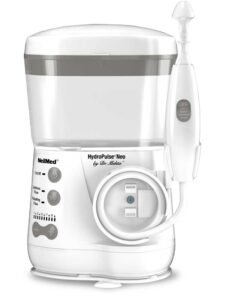What is the Best Solution for Irrigation?
Which Solution Should You Use for Sinus Irrigation? What is the best solution for irrigation?
If you search the literature on nasal irrigation you will find hundreds of articles on using various solutions discussed. The differences are based on the science of pressures caused by osmotic pressure.
Osmotic pressure exists when you have two “containers” separated by a membrane, called a permeable membrane, such as the nasal tissue. If container A is isotonic, and B is the natural human tissue, which is isotonic, then there is no osmotic pressure, since they are both equal. If container A is hypertonic – extra salt – then container A would exert a pressure to draw water out of the other side. That pressure, in science, continues until both containers have equal osmotic pressure.
For nasal irrigation there is:
a. Isotonic saline. This is a saline solution which can be used for many purposes in the human body. It is called isotonic because when it is given, for example, intravenously it doesn’t cause any harm.
b. Hypertonic saline. Here the amount of salt is increased so that the osmotic pressure is much higher than in the body fluids. In theory the extra osmotic pressure would draw off extra fluid. This is toxic if given intravenously
c. Ringer’s solution. This is a special formula that is made to match the body fluid composition. Ringer’s is made up of the elements that are ideally in the body fluids. In the Emergency room, they give Ringer’s solution intravenously to injured patients. Various studies show that this composition is superior for nasal cilia enhancement. (See References at end of this article.) *
Fortunately there is a new publication in the May – June 2014 edition of the American Journal of Rhinology.* Here they tested patients with various saline solution after surgery, to see which one was best to speed healing after surgery.
Normally after the trauma of sinus surgery, it takes many weeks for the nasal tissues to return to normal. This evaluation was a double blinded one where neither the doctor nor the patient knew what they were using.* The seventy four patients filled out questionnaires about nasal symptoms including clear breathing, headache, nasal discomfort, smell, congestion, blockage, drainage, and feeling normal.
The authors concluded that the patients had a better return of nasal relief with the Ringer’s solution.
This article is of particular interest to me, because I have recommended the use of Breathe.ease XL (a Ringer’s Formulation) for my patients and the public. This was based on return of nasal cilia function when Ringer’s is used.** In the Rhinology evaluation, the authors confirm that using Ringer’s for irrigation reduced the symptoms of these patients significantly, much better than regular saline or hypertonic solutions.
Breathe.ease XL matches the elements found in the human tissues. Most patients notice a difference in nasal symptoms when they try other solutions.
A second factor to consider; there are no preservatives in Breathe.ease XL packets, so each solution is made fresh. In the prepared saline packages, there are preservatives such as Benzakonium which may slow or impair nasal cilia.
One of the gratifying results of using Hydro Pulse™ pulsing irrigation with the Ringer’s (Breathe.ease XL) is that patients have reduction of their symptoms much faster, as shown by this American Journal of Rhinology article.
*Hui, Woods, Carney. A double-blind randomized controlled trial of normal saline, lactated Ringer’s and hypertonic saline irrigation. American Journal of Rhinology. May 2014. 255 – 231
**Boek WM, Keles N, Graamans K, et al.: Physiologic and hypertonic saline solutions impair ciliary activity in vitro. Laryngoscope 1999, 109:396–399.
***Boek WM, Graamans K, Natzijl H, et al: Nasal mucociliary transport: new evidence for a key role of ciliary beat frequency. Laryngoscope 2002, 112:570–573

